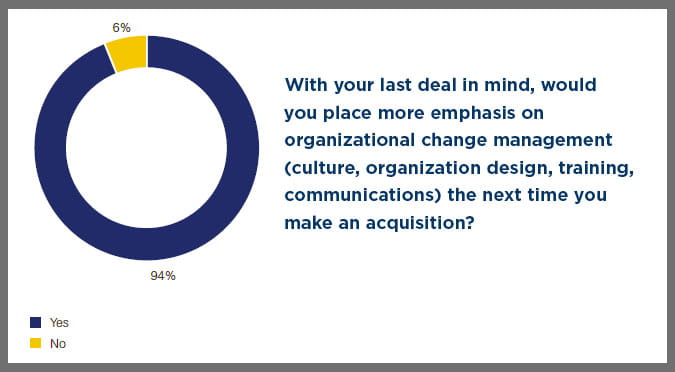
Archive | InBrief
The human touch: Mid-market firms' post-merger integration challenge
The human touch: Mid-market firms' post-merger integration challenge
Mid-market firms face tough tasks when it comes to managing change throughout integration. How can they overcome these challenges? Communication, talent retention and cultural integration are crucial challenges that mid-market firms face. However, companies have several ways to mitigate the risks.
West Monroe Partners conducted a survey that interviewed 30 North American based senior M&A practitioners in mid-market companies (US$300m-US$2bn) from the healthcare, manufacturing and distribution, banking and high-tech sectors. This survey provided insight on the complexities, challenges and efforts mid-market companies face in their quest to fuel growth through acquisitions. Below are three key ways that our respondents identified as good ways to ease the human-based challenges in the integration process.
Start early. Beginning integration planning early is a key way companies can help address personnel challenges. This allows firms to identify problems ahead of time, and allocate resources appropriately. “We started the integration process early so that we can dedicate as much time as possible for this,” says the CEO of a technology firm. “We identified key differences and areas that we needed to address first so that we chose the right communication channels and proper timing to gain the confidence of all employees and prevent any insecurities from impacting our culture in a negative way.
Additionally, it is also a good way to develop a rapport with future colleagues – and creating that kind of atmosphere will ease the integration process. “Interacting with both sets of staff directly and explaining the strategies very early gains quick support for integration success,” says a healthcare CFO. “Communicating changes through the senior team members in a corporate event solved the issues in a light mood and solved the problems quickly for a healthy environment around the firm.”
Get expert advice. Enlisting the help of people with expertise in the area of cultural integration and change management is a good way to gain extra resources for integration, as well as retain value in the human-side of a deal. “The best way was to use an adviser who has the relevant experience of handling these challenges in a deal,” says the CEO of a manufacturing and distribution company. “Our advisers were very helpful in overcoming these challenges as they had a wealth of experience across deal-size and type.”
Be upfront. Acquisitions are always a turbulent time for employees. Acquirers can help to mitigate this to some extent by being open in what the merged entity will entail, and what it means for people’s jobs and futures. It is better to communicate that certain decisions have not yet been made than to communicate nothing. Not communicating increases rumors and fear. “Fear is an obvious by-product of any acquisition,” says a banking CFO. “Mergers almost always lead to job losses, and it is most often the acquired company that loses the most jobs. The integration plan included honest and open communication about potential job changes and organization impact.”



